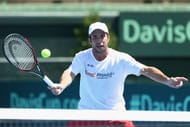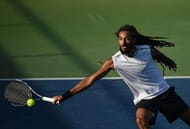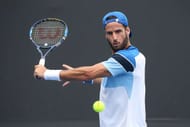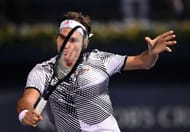A technique once used extensively by the best in the sport, serve-and-volley has taken a backseat as tennis has largely been played from the baseline, a trend that has only taken on more momentum in the past decade. Fewer and fewer players are coming to the net, and there may be many reasons why.
Racquets have become more powerful, and players fitter; a more physical, forceful game combined with slower courts has meant that the game has shifted to the baseline, which means that volleyers have become somewhat of a rare breed.
But some players have in recent years used the technique – with fantastic results.
Here, we look at a few proponents of serve-and-volley in the modern day game:
Mischa Zverev
Consistent and hard-working, Mischa Zverev did not, however see the limelight that his younger brother Alexander has experienced. While Sascha has spent the past year ascending the rankings – and last year won his first ever ATP title, Mischa saw middling results on the Tour.
With Sascha near the top 20 ranks, Mischa, far lower, entered the Australian Open and was drawn against World No. 1 Andy Murray in the fourth round. With the odds at 15-1 on Zverev, he was firmly not the favourite to win this tournament.
However, it was Mischa Zverev’s adept serve-and-volley technique that completely flummoxed a confused Murray this year.
Tennis from the baseline has been the go-to for players this year, and Zverev is by no means a bad baseliner. But his specialty this time around appeared to be the serve-and-volley that Murray was unable to handle. Equipped with a strong forehand, Zverev routinely charged the net, leading to a four-set loss for Andy Murray.
Like many of the best serve-and-volleyers out there, Zverev timed his shots to near-perfection, and at his net approaches took the ball early and slotted it perfectly.
Given that even Roger Federer, who has one of the best serve-and-volley games the sport has ever seen, has switched since to playing from the baseline to combat his ever newer, ever-younger opponents today, fans had not seen the classic style of gameplay in a while.
But Zverev timed his shots so perfectly that many considered it almost a masterclass in the technique.
The German routinely covered more distance than Murray, running to and from the net on multiple occasions. Those net approaches from Zverev translated to some classic attacking tennis, with the older Zverev brother playing some strong wristy forehands in the follow-up.
That was especially staggering considering Zverev had major wrist surgery in 2014 – and has struggled with herniated discs, back issues and more since.
Radek Stepanek
Not so much a full-time serve-and volleyer as an occasional one, Stepanek still uses the technique – and successfully, in both singles and doubles. The Czech ace, like most other volleyers, has found his biggest successes on the quicker grass surfaces.
That technique, on that surface, gave Stepanek some stellar results.
He has since dropped significantly in the singles rankings, but remains, at 38 years of age, in the top 100 players, perhaps because of how much grass courts have slowed down in the past few years.
But running in and playing at the net is a technique that has got the Czech strong doubles results as well.
What is the secret behind Stepanek’s proficiency, one might wonder. The Czech generates a heavy amount of topspin, which with a slower second serve gives him added time to come to the net, playing strong passing shots.
He is also proficient at playing from the baseline, and will play long rallies there – which is what he tends to do for the majority of his play now. But he is still considered one of the few strong volleyers on court, and he is effectively able to mix both techniques.
Dustin Brown
Germany’s Dustin Brown is perhaps one of the last few ‘popular’ exponents of serve and volley in the game. One of the few players who is not particularly comfortable from the baseline, Brown is more an attacker than a defender.
But the tall German has had his biggest successes on grass, a surface that suits his fast serve-and-volley game. Between 2014 and 2015, Brown took two big victories over Rafael Nadal, both of them at Wimbledon, and his serve-and-volley technique was perhaps instrumental in doing so.
Taking his opponents away from the baseline – a useful tactic considering the sheer number of baseline players that have cropped up over the last decade, and how much the game has shifted since, Brown runs to the net for most of his points. In fact, against former No. 1 Rafael Nadal, Brown has won a minimum of 60% of his points in net approaches.
It is the speedy grass surface that suits Brown, and the slowing down of the grass at Wimbledon that may have led to Brown’s downfall; he now competes largely on the Challenger tour, and is now at 82nd in the rankings after once having been a top 20 player.
But he is among the few serve-and-volley proponents in tennis today, and his aggressive, flashy tennis was a good watch when the now 32-year-old was at the top of his form.
Feliciano Lopez
Spain’s Feliciano Lopez , with countryman and Davis Cup teammate Marc Lopez, has found immense success in the doubles, but has done well in the singles too. An adept net player, Lopez is fond of the serve-and-volley technique, and uses it often.
He prefers coming to the net to hit, and unlike Stepanek will sometimes take on rallies at the net. His natural body motion takes him into, and towards the net, although it is more than likely he is more used to training on the clay courts of his home country, Spain.
Lopez has a serve that is both firm and quick, and that, in combination with his comfort at both net and baseline play, have seen the 35-year-old sustain success in both singles and doubles – he is currently World No. 34 in the singles, and 11th in the doubles.
Roger Federer
He is considered the Greatest of All Time in the sport, and it’s no secret that Roger Federer, grass court expert, drew his inspirations from Pete Sampras, whom the Swiss ace has cited on several occasions as his idol.
With Sampras considered among the best proponents of serve-and-volley in the game, it is unsurprising that Federer, who modeled his own game on the American former No. 1, would do much the same.
Now that tennis has seen a paradigm shift from serve-and-volley to baseline, there are perhaps more points up for grabs at the net should someone use the volleying technique. His one-time – and longtime coach, former No. 1 Stefan Edberg had success at Wimbledon, and Federer perhaps used the technique more under his guidance.
Even as recently as two years ago, Federer has been coming to the net more than he did in pevious years.
In a 2015 interview with The New York Times, Federer said “I feel I have much more confidence with the serving and volleying, the chipping and charging,” and that the technique had been ‘enjoyable’.
Federer uses serve-and-volley extensively to break up longer rallies, and with coach Severin Luthi, came up with the SABR – the Sneak Attack by Roger, to surprise his opponents at the net.
Several players have attempted to replicate, or bring his techniques into their own game since.
Who Are Roger Federer's Kids? Know All About Federer's Twins




